recommended oil Hyundai Elantra 2006 Owner's Manual
[x] Cancel search | Manufacturer: HYUNDAI, Model Year: 2006, Model line: Elantra, Model: Hyundai Elantra 2006Pages: 277, PDF Size: 10.18 MB
Page 173 of 277
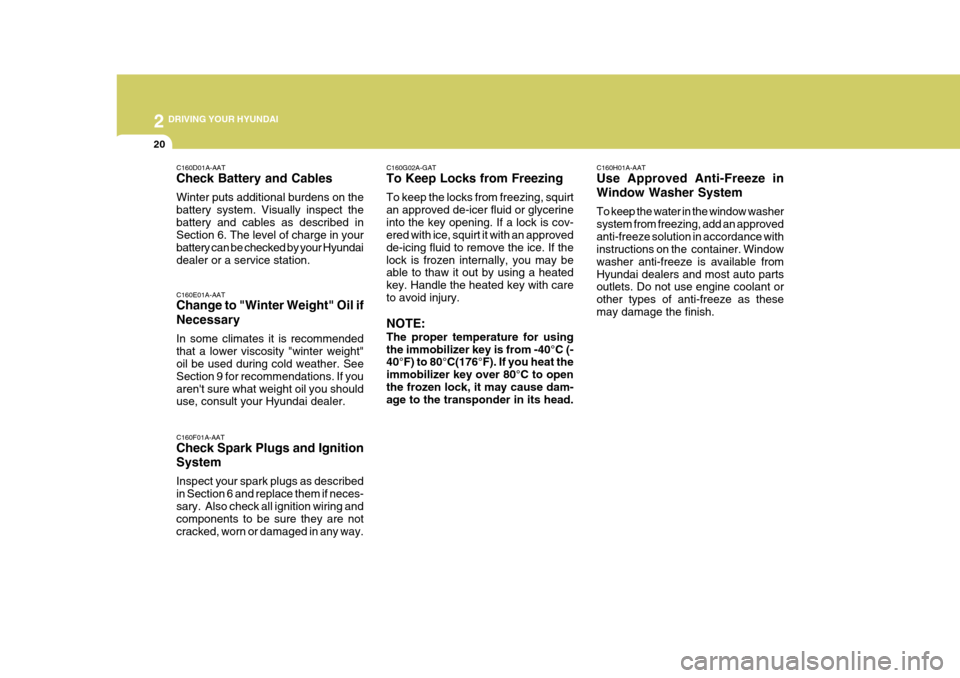
2 DRIVING YOUR HYUNDAI
20
C160H01A-AAT Use Approved Anti-Freeze in Window Washer System To keep the water in the window washer system from freezing, add an approvedanti-freeze solution in accordance with instructions on the container. Window washer anti-freeze is available fromHyundai dealers and most auto parts outlets. Do not use engine coolant or other types of anti-freeze as thesemay damage the finish.
C160G02A-GAT To Keep Locks from Freezing To keep the locks from freezing, squirt an approved de-icer fluid or glycerineinto the key opening. If a lock is cov- ered with ice, squirt it with an approved de-icing fluid to remove the ice. If thelock is frozen internally, you may be able to thaw it out by using a heated key. Handle the heated key with careto avoid injury. NOTE: The proper temperature for using the immobilizer key is from -40°C (- 40°F) to 80°C(176°F). If you heat the immobilizer key over 80°C to openthe frozen lock, it may cause dam- age to the transponder in its head.
C160D01A-AAT Check Battery and Cables Winter puts additional burdens on the battery system. Visually inspect thebattery and cables as described in Section 6. The level of charge in your battery can be checked by your Hyundaidealer or a service station. C160F01A-AAT Check Spark Plugs and Ignition System Inspect your spark plugs as described in Section 6 and replace them if neces-sary. Also check all ignition wiring and components to be sure they are not cracked, worn or damaged in any way.
C160E01A-AAT Change to "Winter Weight" Oil if Necessary In some climates it is recommended that a lower viscosity "winter weight" oil be used during cold weather. See Section 9 for recommendations. If youaren't sure what weight oil you should use, consult your Hyundai dealer.
Page 200 of 277
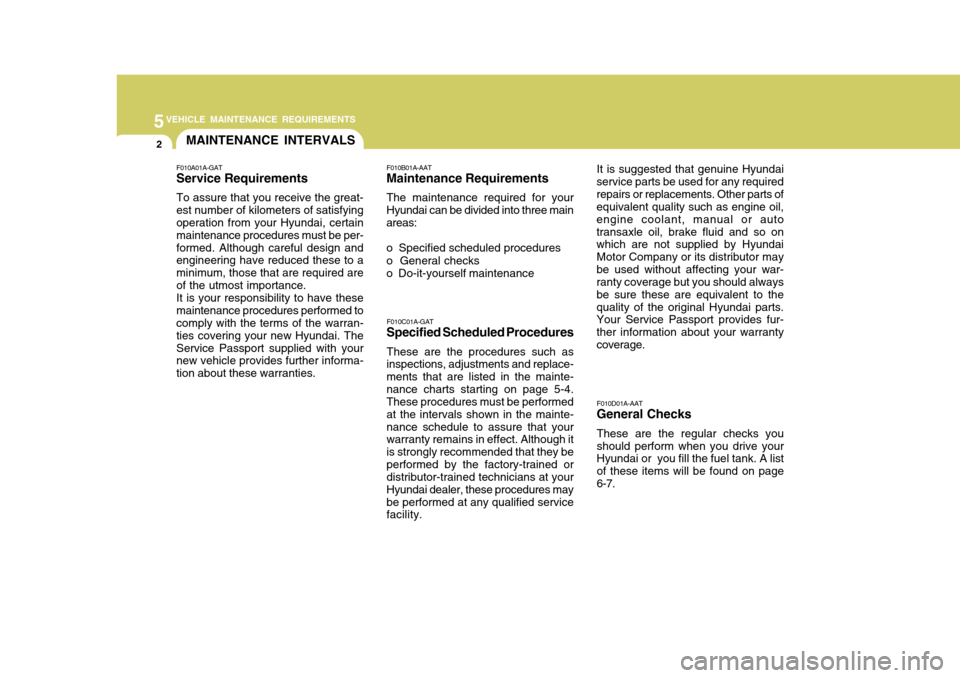
5VEHICLE MAINTENANCE REQUIREMENTS
2MAINTENANCE INTERVALS
F010C01A-GAT
Specified Scheduled Procedures
These are the procedures such as
inspections, adjustments and replace- ments that are listed in the mainte-nance charts starting on page 5-4. These procedures must be performed at the intervals shown in the mainte-nance schedule to assure that your warranty remains in effect. Although it is strongly recommended that they beperformed by the factory-trained or distributor-trained technicians at your Hyundai dealer, these procedures maybe performed at any qualified service facility. F010D01A-AAT
General Checks
These are the regular checks you should perform when you drive your Hyundai or you fill the fuel tank. A list of these items will be found on page6-7.
F010A01A-GAT Service Requirements To assure that you receive the great- est number of kilometers of satisfying operation from your Hyundai, certain maintenance procedures must be per-formed. Although careful design and engineering have reduced these to a minimum, those that are required areof the utmost importance.It is your responsibility to have thesemaintenance procedures performed to comply with the terms of the warran- ties covering your new Hyundai. TheService Passport supplied with your new vehicle provides further informa- tion about these warranties.
F010B01A-AAT
Maintenance Requirements
The maintenance required for your
Hyundai can be divided into three main areas: o Specified scheduled procedures o General checks o Do-it-yourself maintenance It is suggested that genuine Hyundai
service parts be used for any requiredrepairs or replacements. Other parts of equivalent quality such as engine oil, engine coolant, manual or autotransaxle oil, brake fluid and so on which are not supplied by Hyundai Motor Company or its distributor maybe used without affecting your war- ranty coverage but you should always be sure these are equivalent to thequality of the original Hyundai parts. Your Service Passport provides fur- ther information about your warrantycoverage.
Page 217 of 277
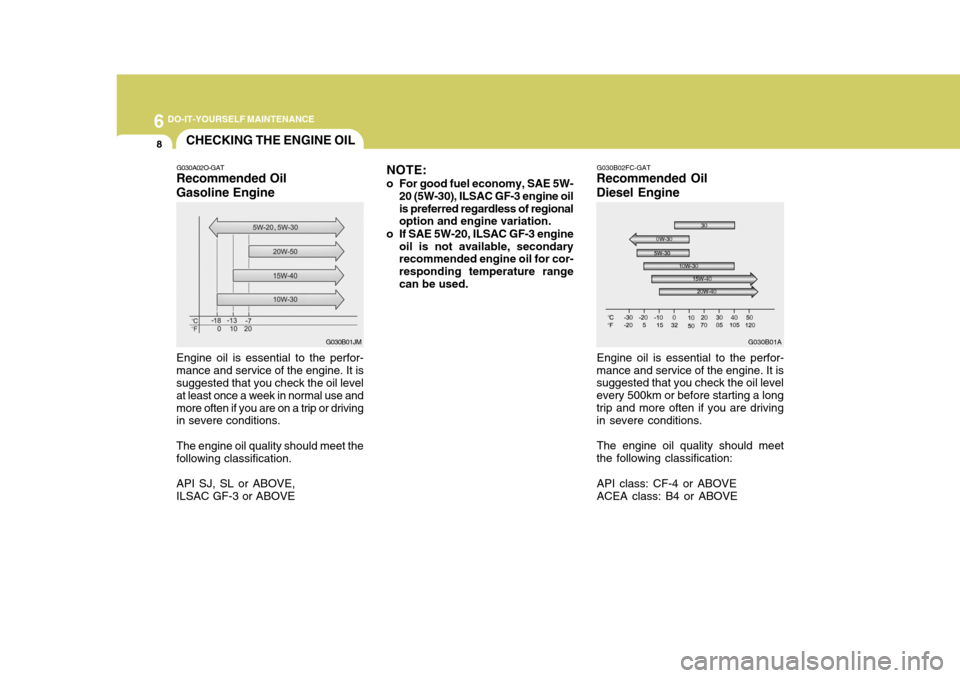
6 DO-IT-YOURSELF MAINTENANCE
8CHECKING THE ENGINE OIL
G030B02FC-GAT
Recommended Oil Diesel Engine
G030B01A
Engine oil is essential to the perfor-
mance and service of the engine. It is suggested that you check the oil level every 500km or before starting a longtrip and more often if you are driving in severe conditions.
The engine oil quality should meet
the following classification:
API class: CF-4 or ABOVE ACEA class: B4 or ABOVE
G030A02O-GAT
Recommended Oil Gasoline Engine Engine oil is essential to the perfor- mance and service of the engine. It is suggested that you check the oil level at least once a week in normal use andmore often if you are on a trip or driving in severe conditions. The engine oil quality should meet the following classification. API SJ, SL or ABOVE, ILSAC GF-3 or ABOVE G030B01JMNOTE:
o For good fuel economy, SAE 5W- 20 (5W-30), ILSAC GF-3 engine oilis preferred regardless of regional option and engine variation.
o If SAE 5W-20, ILSAC GF-3 engine oil is not available, secondaryrecommended engine oil for cor- responding temperature rangecan be used.
Page 218 of 277
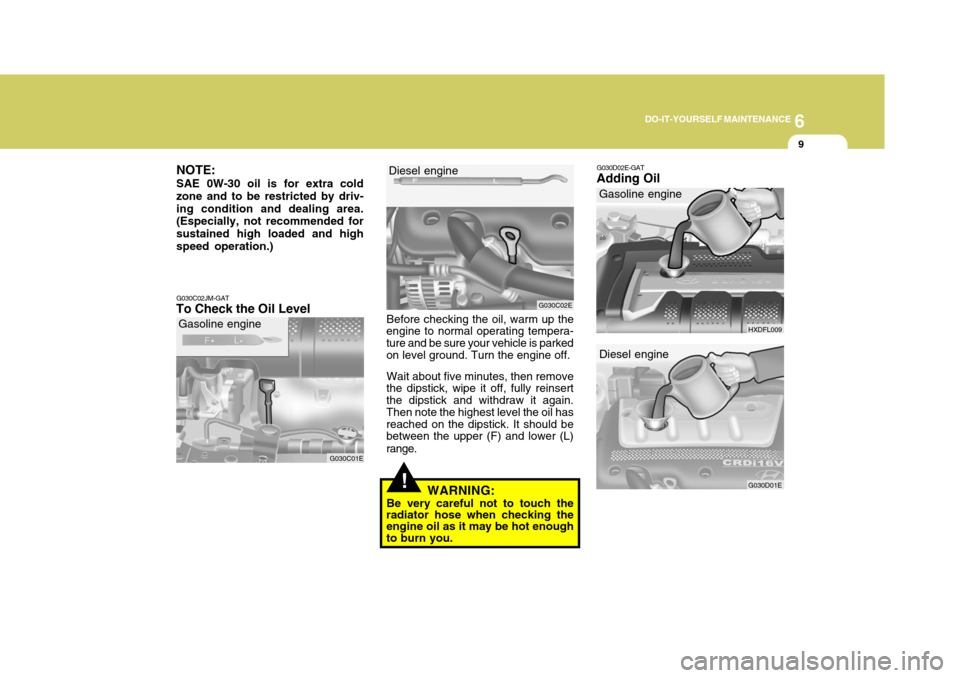
6
DO-IT-YOURSELF MAINTENANCE
9
G030C02JM-GAT
To Check the Oil Level
G030C01E
NOTE: SAE 0W-30 oil is for extra cold zone and to be restricted by driv-ing condition and dealing area. (Especially, not recommended for sustained high loaded and highspeed operation.)
Gasoline engine G030C02E
Diesel engine
G030D02E-GAT
Adding Oil
HXDFL009 G030D01E
Gasoline engine
Diesel engine
!
Before checking the oil, warm up the
engine to normal operating tempera- ture and be sure your vehicle is parked on level ground. Turn the engine off.
Wait about five minutes, then remove
the dipstick, wipe it off, fully reinsert the dipstick and withdraw it again. Then note the highest level the oil has reached on the dipstick. It should be between the upper (F) and lower (L) range.
WARNING:
Be very careful not to touch the
radiator hose when checking the engine oil as it may be hot enough to burn you.
Page 219 of 277
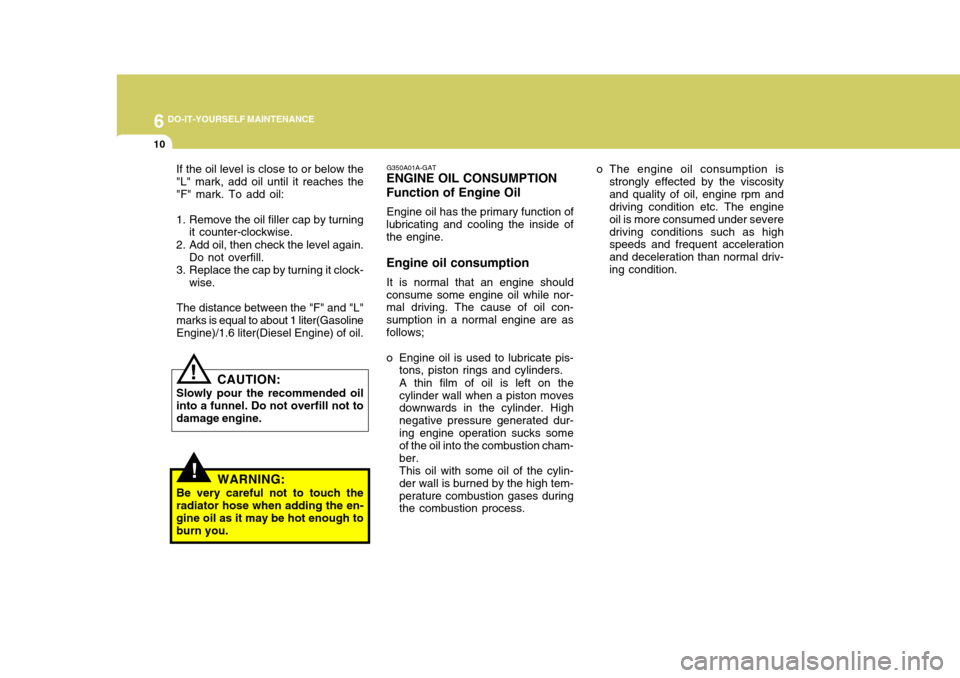
6 DO-IT-YOURSELF MAINTENANCE
10
G350A01A-GAT
ENGINE OIL CONSUMPTION Function of Engine Oil
Engine oil has the primary function of
lubricating and cooling the inside of the engine. Engine oil consumption
It is normal that an engine should
consume some engine oil while nor- mal driving. The cause of oil con- sumption in a normal engine are asfollows;
o Engine oil is used to lubricate pis- tons, piston rings and cylinders. A thin film of oil is left on the cylinder wall when a piston moves downwards in the cylinder. High negative pressure generated dur-ing engine operation sucks some of the oil into the combustion cham- ber.This oil with some oil of the cylin-der wall is burned by the high tem-perature combustion gases during the combustion process. o The engine oil consumption is
strongly effected by the viscosity and quality of oil, engine rpm and driving condition etc. The engine oil is more consumed under severedriving conditions such as high speeds and frequent acceleration and deceleration than normal driv-ing condition.
If the oil level is close to or below the"L" mark, add oil until it reaches the"F" mark. To add oil:
1. Remove the oil filler cap by turning
it counter-clockwise.
2. Add oil, then check the level again. Do not overfill.
3. Replace the cap by turning it clock- wise.
The distance between the "F" and "L" marks is equal to about 1 liter(Gasoline Engine)/1.6 liter(Diesel Engine) of oil.
!
! CAUTION:
Slowly pour the recommended oil into a funnel. Do not overfill not todamage engine.
WARNING:
Be very careful not to touch theradiator hose when adding the en-gine oil as it may be hot enough to burn you.
Page 221 of 277
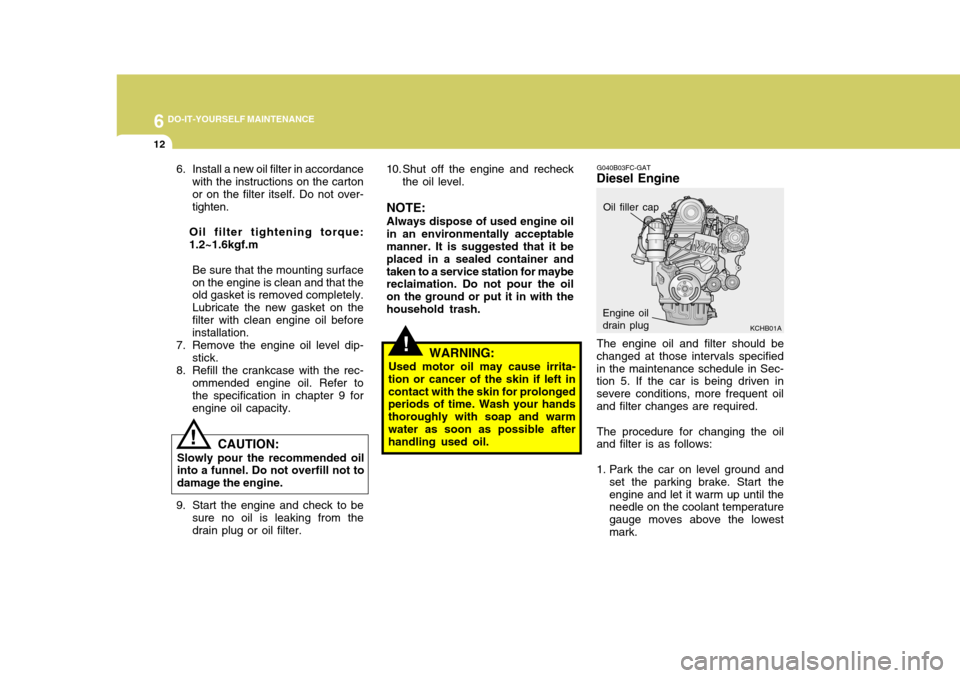
6 DO-IT-YOURSELF MAINTENANCE
12
!
G040B03FC-GAT
Diesel Engine
KCHB01A
The engine oil and filter should be
changed at those intervals specified in the maintenance schedule in Sec- tion 5. If the car is being driven in severe conditions, more frequent oiland filter changes are required.
The procedure for changing the oil
and filter is as follows:
1. Park the car on level ground and
set the parking brake. Start the engine and let it warm up until the needle on the coolant temperature gauge moves above the lowestmark.
10. Shut off the engine and recheck
the oil level.
NOTE: Always dispose of used engine oil in an environmentally acceptable manner. It is suggested that it be placed in a sealed container andtaken to a service station for maybe reclaimation. Do not pour the oil on the ground or put it in with thehousehold trash.
6. Install a new oil filter in accordance
with the instructions on the cartonor on the filter itself. Do not over- tighten.
Oil filter tightening torque: 1.2~1.6kgf.m Be sure that the mounting surfaceon the engine is clean and that the old gasket is removed completely. Lubricate the new gasket on thefilter with clean engine oil before installation.
7. Remove the engine oil level dip- stick.
8. Refill the crankcase with the rec- ommended engine oil. Refer tothe specification in chapter 9 for engine oil capacity. WARNING:
Used motor oil may cause irrita-
tion or cancer of the skin if left incontact with the skin for prolonged periods of time. Wash your hands thoroughly with soap and warmwater as soon as possible after handling used oil.
Oil filler cap
Engine oil drain plug
! CAUTION:
Slowly pour the recommended oil into a funnel. Do not overfill not to damage the engine.
9. Start the engine and check to be sure no oil is leaking from the drain plug or oil filter.
Page 223 of 277
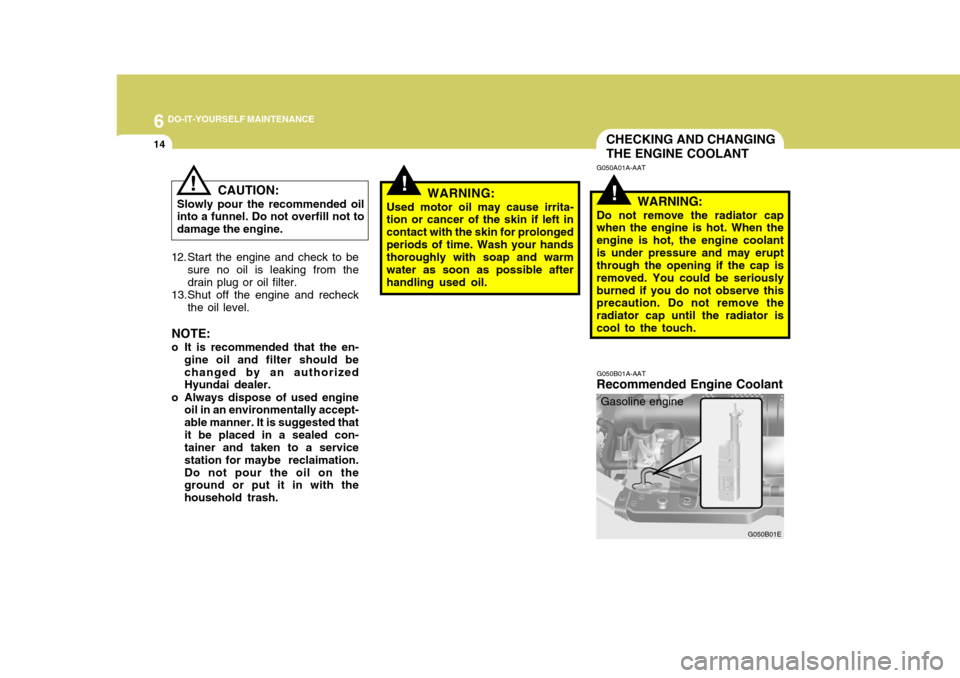
6 DO-IT-YOURSELF MAINTENANCE
14
!!
CHECKING AND CHANGING THE ENGINE COOLANT
G050B01A-AAT
Recommended Engine Coolant
G050B01E
G050A01A-AAT
WARNING:
Do not remove the radiator cap when the engine is hot. When the engine is hot, the engine coolantis under pressure and may erupt through the opening if the cap is removed. You could be seriouslyburned if you do not observe this precaution. Do not remove the radiator cap until the radiator iscool to the touch.
WARNING:
Used motor oil may cause irrita- tion or cancer of the skin if left in contact with the skin for prolongedperiods of time. Wash your hands thoroughly with soap and warm water as soon as possible afterhandling used oil.
Gasoline engine
12. Start the engine and check to be
sure no oil is leaking from thedrain plug or oil filter.
13.Shut off the engine and recheck the oil level.
NOTE:
o It is recommended that the en- gine oil and filter should bechanged by an authorized Hyundai dealer.
o Always dispose of used engine oil in an environmentally accept- able manner. It is suggested thatit be placed in a sealed con- tainer and taken to a service station for maybe reclaimation.Do not pour the oil on the ground or put it in with the household trash.
! CAUTION:
Slowly pour the recommended oil into a funnel. Do not overfill not to damage the engine.
Page 230 of 277
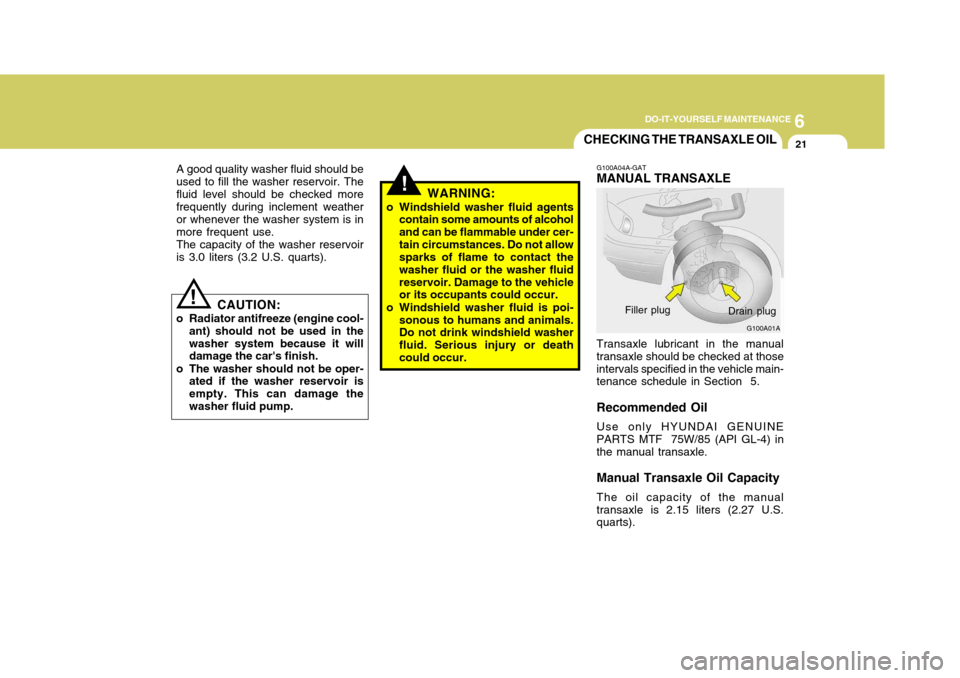
6
DO-IT-YOURSELF MAINTENANCE
21CHECKING THE TRANSAXLE OIL
!
G100A01A
G100A04A-GAT MANUAL TRANSAXLE Transaxle lubricant in the manual transaxle should be checked at thoseintervals specified in the vehicle main- tenance schedule in Section 5. Recommended Oil Use only HYUNDAI GENUINE PARTS MTF 75W/85 (API GL-4) in the manual transaxle. Manual Transaxle Oil Capacity The oil capacity of the manual transaxle is 2.15 liters (2.27 U.S. quarts). Drain plug
Filler plug
!
A good quality washer fluid should be used to fill the washer reservoir. Thefluid level should be checked more frequently during inclement weather or whenever the washer system is inmore frequent use.The capacity of the washer reservoiris 3.0 liters (3.2 U.S. quarts).
CAUTION:
o Radiator antifreeze (engine cool- ant) should not be used in thewasher system because it will damage the car's finish.
o The washer should not be oper- ated if the washer reservoir is empty. This can damage thewasher fluid pump. WARNING:
o Windshield washer fluid agents contain some amounts of alcoholand can be flammable under cer-tain circumstances. Do not allow sparks of flame to contact the washer fluid or the washer fluidreservoir. Damage to the vehicle or its occupants could occur.
o Windshield washer fluid is poi- sonous to humans and animals.Do not drink windshield washer fluid. Serious injury or death could occur.
Page 231 of 277
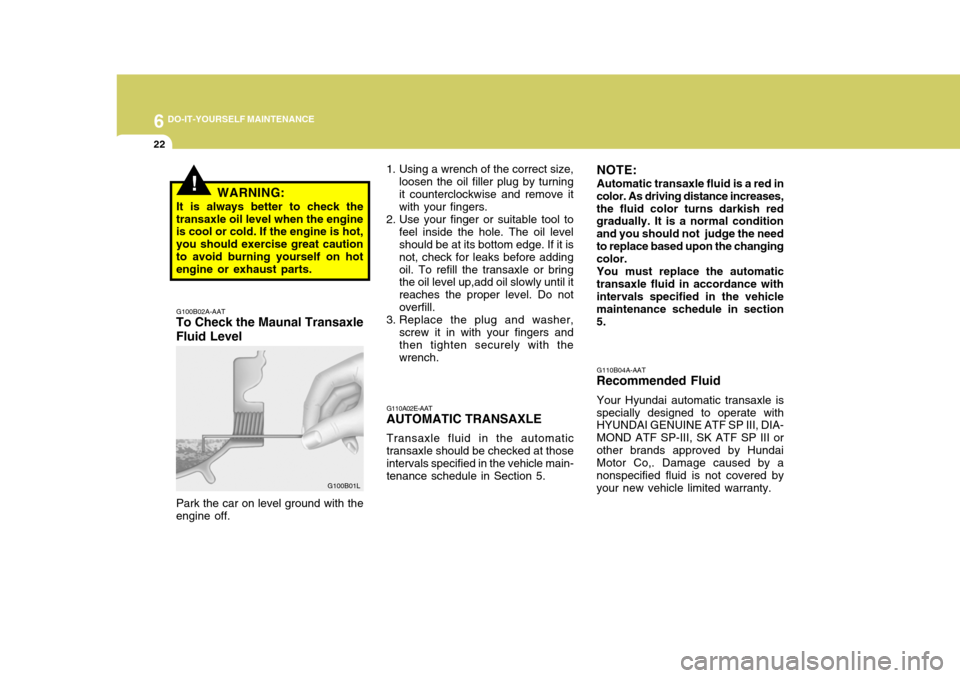
6 DO-IT-YOURSELF MAINTENANCE
22
1. Using a wrench of the correct size,
loosen the oil filler plug by turning it counterclockwise and remove it with your fingers.
2. Use your finger or suitable tool to feel inside the hole. The oil levelshould be at its bottom edge. If it is not, check for leaks before addingoil. To refill the transaxle or bring the oil level up,add oil slowly until it reaches the proper level. Do notoverfill.
3. Replace the plug and washer, screw it in with your fingers and then tighten securely with the wrench.
G110A02E-AAT
AUTOMATIC TRANSAXLE
Transaxle fluid in the automatictransaxle should be checked at those intervals specified in the vehicle main- tenance schedule in Section 5.
G100B02A-AAT
To Check the Maunal Transaxle Fluid Level
G100B01L
Park the car on level ground with the
engine off. G110B04A-AAT
Recommended Fluid
Your Hyundai automatic transaxle is
specially designed to operate with HYUNDAI GENUINE ATF SP III, DIA- MOND ATF SP-III, SK ATF SP III orother brands approved by Hundai Motor Co,. Damage caused by a nonspecified fluid is not covered byyour new vehicle limited warranty. NOTE: Automatic transaxle fluid is a red in
color. As driving distance increases, the fluid color turns darkish red gradually. It is a normal condition and you should not judge the needto replace based upon the changing color.
You must replace the automatic
transaxle fluid in accordance withintervals specified in the vehicle maintenance schedule in section5.
!WARNING:
It is always better to check the
transaxle oil level when the engine is cool or cold. If the engine is hot, you should exercise great cautionto avoid burning yourself on hot engine or exhaust parts.
Page 244 of 277
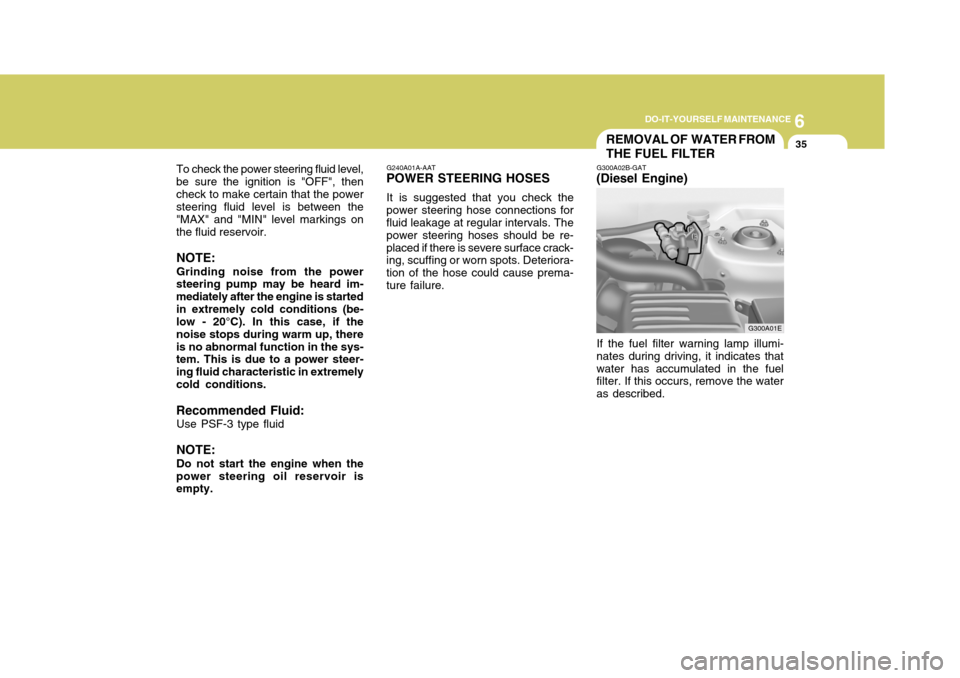
6
DO-IT-YOURSELF MAINTENANCE
35REMOVAL OF WATER FROM THE FUEL FILTER
G300A02B-GAT
(Diesel Engine)
G300A01E
G240A01A-AAT
POWER STEERING HOSES
It is suggested that you check the
power steering hose connections for fluid leakage at regular intervals. The power steering hoses should be re-placed if there is severe surface crack- ing, scuffing or worn spots. Deteriora- tion of the hose could cause prema-ture failure.
To check the power steering fluid level,
be sure the ignition is "OFF", thencheck to make certain that the power steering fluid level is between the "MAX" and "MIN" level markings onthe fluid reservoir.
NOTE: Grinding noise from the power
steering pump may be heard im- mediately after the engine is startedin extremely cold conditions (be- low - 20°C). In this case, if the noise stops during warm up, thereis no abnormal function in the sys- tem. This is due to a power steer- ing fluid characteristic in extremelycold conditions. Recommended Fluid:
Use PSF-3 type fluidNOTE: Do not start the engine when the
power steering oil reservoir is empty. If the fuel filter warning lamp illumi-
nates during driving, it indicates that water has accumulated in the fuel filter. If this occurs, remove the water as described.